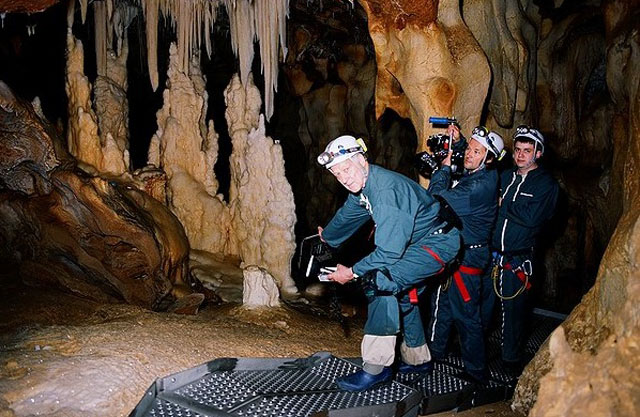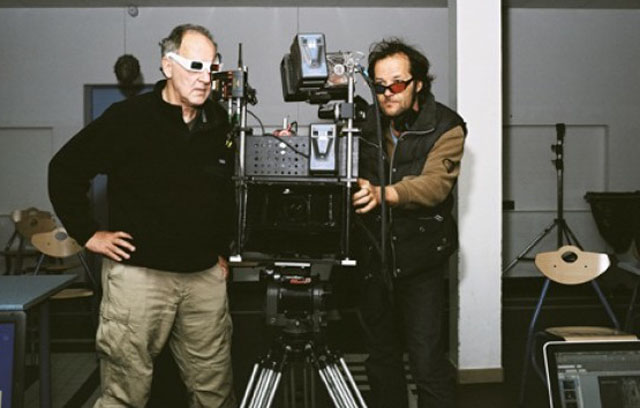CHICAGO – In anticipation of the scariest week of the year, HollywoodChicago.com launches its 2024 Movie Gifts series, which will suggest DVDs and collections for holiday giving.
Beguiling, Hypnotic ‘Cave of Forgotten Dreams’
 Rating: 3.5/5.0 |
CHICAGO – Where are the vital connections between our ancient ancestors and our creative, technological selves? Prehistoric cave drawings, the oldest ever discovered, are showcased in Werner Herzog’s new documentary, “Cave of Forgotten Dreams.” The link between who they are and who are we becomes the theme of this remarkable exposition.
Herzog, one of the most provocative and unusual living film artists, fashions a narrative zen state in this document, as his cameras lovingly express and pan across the primitive art. The narration is spare, and when enhanced by talking heads only strives to provide the basic information to appreciate the images on there own, and then is shown again and again.
For over 20,000 years, Chauvet Caves in Southern France had been sealed by a fallen rock face, its football field size interior preserved and untouched. In 1994, a team of scientists, led by Jean-Marie Chauvet, found the cave by measuring for hidden wind gusts from the rocks. When the team opened a narrow passage they discovered the miracle of the main room, filled with artwork that had remained unchanged since the so-called Aurignacian era (30,000-32.000 years ago).
Hundreds of animal paintings were catalogued from this find, depicting at least 13 different species. as well as hand prints and foot prints that could be the earliest human proof that can be dated accurately. Fossils of various species are also found, some imbued with a crystallization from years of water drippings that create a even more magical sense of presence.
 Photo credit: Marc Valesella for IFC Films |
Cave of Forgotten Dreams is a history, a meditation and a treatise on the nature of art. It is also a direct thought-piece on who we are and what it means to communicate through the ages with our ancient and similarly motivated selves. Often art is simply the broadcasting of our own mysteries and fears, drawn on a cave wall.
Werner Herzog is the guide in the documentary, and it is his narrator voice that adds a touch of wonder and sensibility to the whole film. His feature films (“The Bad Lieutenant: Port of Call New Orleans”) and previous non-fiction (“Grizzly Man”) have focused primarily on human motivations, so in this story he gravitates back to the humanity of the long-dead artists. To Herzog, the wonder of the preservation is how it immortalizes a connection to the originators, to affix them to our own being.
The documentary part, the talking heads, are also a unique mix. He talks to the usual scientists and archaeologists, but also tries to break down the wall between the stale take of “eras” towards a more exceptional viewpoint of the actual animals and people. The highlights were a couple demonstrations; an effective ancient spear thrown clumsily by a modern scientist and another adventurer/researcher who showed how to distinguish the gases emanating from the face of the sheer cliffs, similar to how the paintings were found.
The meditation of the shots used to look at the paintings were comprehensive and at times redundant. Herzog pans over the paintings and etchings in a repetitive way as to lull and mesmerize. This was shot in 3D, and he uses the technology to give a sense of form to the art, with the shape of the original cave canvases providing more meaning to the renderings and creating at times a vibration or movement about them.
Herzog also chooses to end the film in a very subtle way, making a comparison with a species that has evolved from how France adapts its nuclear power plant’s heating capacity. The new eco-system that has developed is emblematic of how we developed from the expression of those ancient paintings to our perception of them today.
 Photo credit: Marc Valesella for IFC Films |
In a way, Cave of Forgotten Dreams is a vacation from our present reality. As the camera records the inner workings to a nth degree on a number of cave drawings, the mind drifts to a secular, almost DNA-like response. This is where we come from and with its power and beauty it can also teach us where we are going.
Everything that came from those drawings – superstition, social structure, religion, intellect and technical progress – is traceable to an individual soul frantically recording a momentary inspiration in a way that was destined to be frozen in time, then lost and then found. The miracle of that discovery means that the inspiration echoes, and teaches us profoundly about who they were, and who we are.
 | By PATRICK McDONALD |


